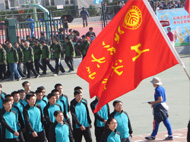报告人: Prof. Lim Chwee-Teck
NUS Life Sciences Institute, Singapore-MIT Alliance, Division of Bioengineering & Dept of Mechanical Engineering National University of Singapore
Seminar #1
题目:Electrospun Composite Nanofibers for Biomedical Applications
主持人:韩平畴 教授
时间:8月13日(周三)上午10:00
地点:廖凯原楼 2-401会议室
Seminar #2
题目:Nanobiomechanics Approaches in the Study of Human Diseases
主持人:梁兴杰 教授
时间:8月14日(周四)上午10:00
地点:中国国家纳米科学中心二楼中部会议室
欢迎广大师生光临!
联系人:原波 6275-2418
Seminar #1- Electrospun Composite Nanofibers for Biomedical Applications
The last decade has seen significant progress made in the fabrication of nanofibers using an ultrafine fiber fabrication technique called electrospinning. One of the major driving momentums to it is the potential use of nanofibers for various biomedical applications, in particular, tissue engineering or regenerative medicine. Electrospun nanofibers are able to emulate the architecture of native extracellular matrix (ECM), a complex fibrous network of proteins and glycosaminoglycans with hierarchical dimensions down to nanometer scale. Electrospun nanofibers can therefore provide in vivo like nanomechanotransductive signaling cues to the cells for establishing apposite cell-scaffold interactions and promoting functional changes between and within cells towards the synthesis of genuine extracelluar matrix over time. Under this context, this presentation will give an overview of our recent research work concerning the development of electrospun composite nanofibers in the form of blended, core-shell structured nanofibers and nanofibers mingled structures as possible biomimetic and bioactive cellular scaffolds for tissue engineering applications.
Seminar #2-Nanobiomechanics Approaches in the Study of Human Diseases
The human body, as a physical entity, is constantly subjected to stresses and strains throughout life. As such, the health and function of organs, tissues and even cells can be affected by these physical interactions and their associated mechanical properties. For example, any deviations in the structural and mechanical properties of a living cell can not only affect its physiological functions, but can also lead to diseases such as malaria and cancer. Cell and molecular biomechanics which deals essentially with forces acting on individual living cells and biomolecules and the effects produced by such forces, play an important role in the study of human diseases.
During the onset of a disease, a cell may experience alterations in both the composition and organization of its cellular structural features. Changes in the structural and mechanical properties of the cell, such as deformability and cell adhesiveness, may arise as these properties are reflective of the compositional and structural changes in the cell. Using cell and molecular biomechanics approaches, we can now study and quantify minute mechanical influences acting on individual cells and biomolecules. In fact, knowing the effect of tiny forces, as small as a few piconewtons, acting on a living cell can reveal ways by which diseased cells differ from healthy ones. It can also help us better understand and establish possible connections between the mechanics of living cells and the onset and progression of human disease so as to assist in developing effective diagnostics for disease detection. Arising from these developments in the last decade or so, some novel and state-of-the-art nanotechnological and biophysical techniques have been developed to probe biological structures at both the cellular and molecular levels. These biomechanical and biophysical investigations can provide a quantitative way of studying physical changes occurring in individual cells during disease onset and progression.
Here, we will highlight studies on human diseases such as malaria and cancer. The nanotechnological and biophysical techniques used include atomic force microscopy, optical tweezers, microfluidics as well as micropipette aspiration assay. It is hoped that from these studies, new and efficient methods of detection and diagnosis may be developed since malaria and cancer are examples of diseases that exhibit changes in the mechanical properties during disease progression.
Bio-Data
Dr C.T. Lim first obtained his B.Eng (1st Class Hons) degree from the National University of Singapore and then his PhD degree from the University of Cambridge, UK. He is an Associate Professor and holds joint appointment at both the Division of Bioengineering and the Department of Mechanical Engineering and is also a Fellow of the Singapore-MIT Alliance. He is currently the Deputy Director of the university’s Life Sciences Institute. Dr Lim heads the Nano Biomechanics Lab which conducts research on nanobiomaterials such as electrospun nanofibers with a focus on biomedical applications. Dr Lim has authored or co-authored about 300 scientific publications, 13 invited/leading/review articles and delivered more than 100 invited talks in international conferences as well as academic institutions. He has also won several research awards including an Outstanding Paper Award at a MRS Fall Meeting. His research was recently cited by MIT Technology Review as one of the top ten emerging technologies of 2006 that will "have a significant impact on business, medicine or culture".









